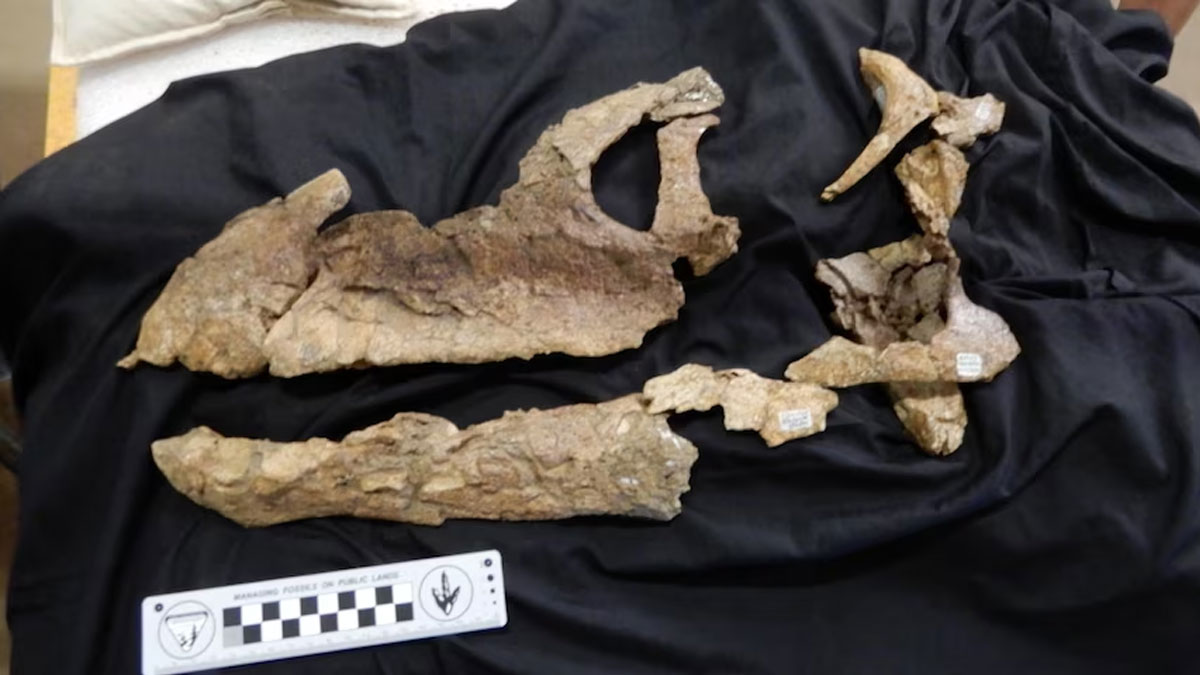
The nearly complete skull of a 95-million-year-old sauropod dinosaur named "Ann" found in Central Queensland, has unearthed new insights into how the massive creature lived.
Researchers found the skull belonged to the species Diamantinasaurus matildae, known for having small heads, long necks and tails, barrel-like bodies, and four columnar legs.
Stephen Poropat, lead researcher from Curtin University's School of Earth and Planetary Sciences, said Ann is the first sauropod dinosaur found in Australia to include most of its skull, and the first Diamantinasaurus to have its back foot preserved.
"This skull gives us a rare glimpse into the anatomy of this enormous sauropod that lived in north-east Australia almost 100 million years ago," Dr Poropat said.
"In analysing the remains, we found similarities between the 'Ann' skull and the skull of a titanosaur called Sarmientosaurus musacchioi, which lived in South America at about the same time as Diamantinasaurus lived in Queensland.
"These include details of the brain case, the bones forming the back end of the skull near the jaw joint, and in the shape of the teeth (which are conical and curved)."
Searching for greener pastures
Dr Poropat said his team's research supported previous theories that sauropods were travelling between continents in search of more balmy weather.
"We suggest that sauropods were travelling between Australia and South America, via Antarctica, during the mid-Cretaceous. Warmer conditions that far south might have been favourable for them.
"The window between 100 and 95 million years ago was one of the warmest in Earth's geologically recent history, meaning that Antarctica, which was more or less where it is now, had no ice.
"Similarly, Australia, which was much further south than today, was warmer with less seasonality.
"In that climate, Antarctica was forested, and might have been an attractive habitat or pathway for wandering sauropods."
He said the species was one of the latest dinosaurs to exist.
"Our research suggests that Diamantinasaurus was one of the most 'primitive' titanosaurs.
"Gaining a better understanding of this species might explain why titanosaurs were so successful, across so much of the world, right until the end of the Age of Dinosaurs."
Predator or prey?
The Diamantinasaurus was around 20 metres long and weighed up to 25 tonnes.
"It would be able to peer into a two or three-storey building, it was about as heavy as four average African elephants and about as long as a tennis court," Dr Poropat said.
But as a placid herbivore, it wouldn't have been much cause for concern if you came across one in the wild.
"Being pursued by a sauropod would've been like being pursued by a turtle," Dr Poropat said.
"They were not fast moving. They were not terribly brainy, and you look at their teeth, they're not adapted for eating prey at all."
A palaeontology paradise Ann's skull was found in 2018 on Elderslie Station, near Winton, by the Australian Age of Dinosaurs Museum during its annual dinosaur dig.
It was the third fossil specimen of Diamantinasaurus matildae to be discovered on Elderslie by the museum and the fourth specimen overall.
In 2012, the fossils of "Ollie" were unearthed, the first juvenile sauropod to ever be found in Australia.
The excavation process found dozens of fossils, including thoracic vertebrae, ribs, a scapula, a humerus, a thumb claw and a femur.
In 2019, 17 curved teeth were found at the site, changing what researchers knew about how the sauropod would have smiled.
Story By: Alex Brewster
Original Story Link: https://www.abc.net.au/news/2023-04-12/queensland-sauropod-dinosaur-skull-found/102198990
Stay tuned for the latest news on our radio stations

